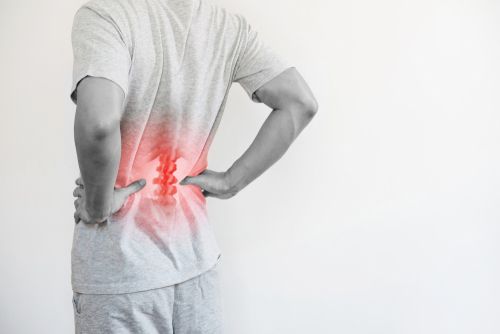Lumbar Discography
Lumbar Discography
Lumbar discography is a procedure for diagnosing painful tears in intervertebral discs in the lower back. This information sheet will explain what it is. Your doctor can explain if it is for you.
What are intervertebral discs?
Intervertebral discs are found between the vertebrae (the bones) of the spine. These soft discs cushion the vertebrae, hold them together, and control motion. They are located in the neck, upper back and lower back. Each disc has two parts. The inner part is called the nucleus, and the outer part is called the annulus. The annulus has nerve endings that are sensitive to pain.

What causes pain in a disc?
If a disc tears, chemicals inside the nucleus may leak out. This can inflame the nerves in the outer part of the disc, the annulus, and cause pain. Nerve roots and the protective covering of the spinal cord (called the dura) are also sensitive to these chemicals. In the low back, it causes low back and/or leg pain. An untreated disc tear may cause a disc to bulge or herniate. This can further inflame or compress the nerve roots and cause even more pain. This means early diagnosis of disc tears is important.
How do I know if I have disc pain?
If you have pain in your lower back or legs, and it has not improved with treatment, you may have disc pain. Common tests such as MRIs can show disc bulges and nerve root compression, but may not always show tears or leaks in discs. Discography is the best way to diagnose torn discs.
What is a discography?
Discography is a procedure that helps your doctor find disc tears that may be causing your pain. During discography, a thin needle is inserted into the center of a disc. An x-ray contrast dye will be injected into the disc to identify wether or not the disc is painful. The dye will outline the tears in the disc. This is often done to several discs to find the specific disc or discs that are causing your pain.
What happens during discography?
Discography may start with an IV sedation (medicine given intravenously) to help you relax. A local anesthetic will be used to numb your skin. The doctor will then insert a thin needle directly into a disc. Fluoroscopy, a type of x-ray, must be used to ensure the safe and proper position of the needle. A dye will be injected to outline the tear. It is important to describe any pain you feel to your doctor. During discography, a healthy disc will not cause your usual pain but a torn disc may. If you feel a different pain or soreness, be sure to explain that it hurts but it’s not your usual pain. This will help the doctor determine which discs may be responsible for your pain.
What happens after discography?
You will be monitored for up to 30 minutes after the procedure. When you are ready to leave, the clinic will give you discharge instructions. You will be sent for a CT scan to get an image of your discs. You may feel increased pain in your back after discography. This indicates your doctor may have found the source of your pain. You can usually return to work a day or two after discography, but always check with your doctor.
Location:
6801 Mcpherson Road Suite 334 Laredo, TX 78041
Phone:
Hours:
Mon - Thu : 7:00am - 5:00pm
Fri : 7:00am - 4:00pm

